C.P. RUGGLES
Montreal Engineering Company Limited
Garrison Place, P.O. Box 3478
1526 Dresden Row
Halifax, N.S. B3J 3J1
Canada
Regular migrations of some fishes between fresh and sea or brackish waters along more or less extended stretches of rivers provide special opportunities for sampling. Because of this behaviour the sampling techniques differ from most described in the preceding chapters. Many of them have been developed for studying both Pacific and Atlantic salmon, the best known fishes among the migratory ones. Some of these techniques can be adapted for sampling other species displaying similar behaviour.
The purpose of this chapter is to review sampling techniques presently employed in North America and Europe to obtain biological data during the migratory phases in the salmon's life history. Emphasis is placed on Atlantic salmon and large rivers rather than on streams, and the collection and interpretation of data are related to the solution of practical fishery management problems.
A variety of devices are used to assist upstream migrating Atlantic salmon past dams, waterfalls and difficult rapids in North America and Europe.
In the Saint John River, New Brunswick, Canada, three types of fish passage facilities provide opportunity to gather biological information on long-term trends in salmon populations. This 676-km long river has been extensively developed for hydroelectric power.
At one of the dams, a collection gallery and pool and weir fishway provides fish passage above the dam. A counting trap, a temporary wodden structure, was operated at the fish ladder exit to count and sample runs of ascending salmon from the beginning of each migration season to its end over the period 1953–1967. Fish were released up to several times daily, depending on run intensity. A floating false floor was used to facilitate counting and the detection of tagged or marked salmon (Figure 10.1).
At another dam on the Saint John River, a mechanical hoist for lifting salmon over the dam is utilized. Fish enter a collection gallery located over the draft tubes of the powerhouse and are led by attraction flows to a hopper located adjacent to the powerhouse (Figure 10.2). The hopper, or skip, rests in a pool and a V-shaped entrance gate leads into its side. When the skip is raised, fish and a relatively small quantity of water are lifted by a solid steel box floor until the skip reaches the top of the dam. At this point it tips forward, dumping its contents of fish and water into the forebay. Counts of fish are made by observation in the hopper. Ease in counting is facilitated by division of the floor of the hopper into four smaller parallel compartments.
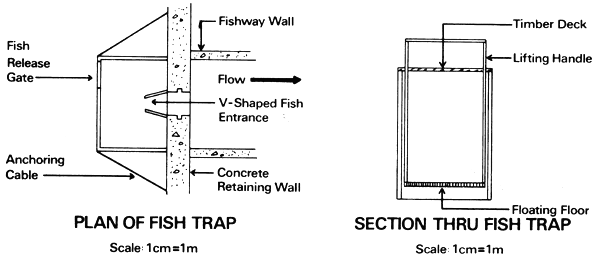
Figure 10.1 Fish counting trap at the exit from the fishway at the Tobique dam on the Saint John River
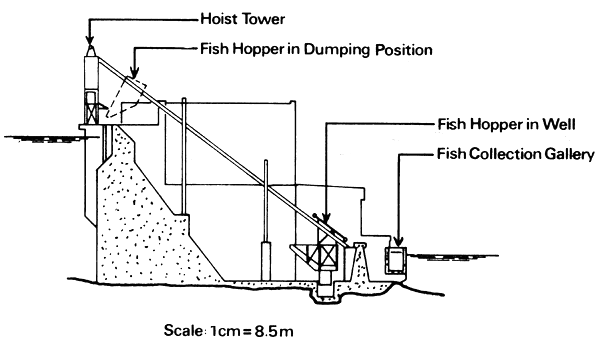
Figure 10.2 Section through the skip hoist used to pass upstream migrating fish over the dam on the Saint John River
The third site where Atlantic salmon runs are monitored on the Saint John River is at the 34-metre high Mactaquac dam. Here, all upstream migrating fish are trapped and transported by tank truck to various destinations in the river system.
Salmon counts collected from the various fish passage facilities at the hydroelectric dams, combined with commercial and sport fishing statistics, have enabled mean annual estimates of stock distribution to be made (Table 10.1).
| Time period | Commercial fishery | Sport fishery | Spawning escapement | Total |
|---|---|---|---|---|
| 1952–56 | 13,642 | 2,669 | 8,381 | 24,692 |
| 1957–61 | 16,202 | 2,085 | 3,667 | 21,954 |
| 1962–66 | 17,002 | 2,582 | 6,913 | 26,497 |
| 1967–71 | 8,006 | 968 | 4,703 | 13,677 |
| 1972–76 | 186 | 2,709 | 17,312 | 20,207 |
Estimates of spawning escapement have been particularly useful in forecasting the magnitude of runs returning five and six years hence. Because of the adverse effects of hydroelectric development and water pollution, a drastic reduction in the commercial fishery was required to rebuild an adequate spawning escapement. The dramatic increase in spawning escapement from 4,703 in the period 1967–71 to more than 17,000 in the next period (see Table 10.1) indicates that the salmon population is responding to the management action taken.
Despite extensive hydroelectric development and impaired water quality, due to industrial pollution, Atlantic salmon still return in relatively large numbers to the Saint John River.
By marking hatchery smolts and subsequent recovery the relative contribution of hatchery-produced Atlantic salmon is known. The contribution of hatchery-reared smolts rose from 1.8 percent of the total run in 1970 to 43 percent in 1976. Numbers of returning adult hatchery-produced fish rose from 94 in 1970 to 9,318 in 1976. The fish collection facility at the Mactaquac dam provides an opportunity to isolate all hatchery-reared Saint John River salmon from naturally-produced salmon; thus selective breeding of specific hatchery strains can be utilized as a management tool.
In the Columbia River, situated on the northwest coast of the United States, over 1.5 million Pacific salmon and steelhead trout are counted each year as they ascend a variety of fishways at twelve major dams. Usually migrating adult fish are counted as they move over white counting boards where they can be easily seen by observers situated in a cubicle near the water surface. The depth of the counting board and the elevation of the cubicle are adjustable for varying water levels. Various techniques are used to control light intensity and water turbulance to prevent delays in the counting area. At some dams, fish counts are made through large viewing windows set in the side of a fishway (Trefethen and Collins, 1975).
A promising technique for automation of fish counting now being field-tested in the western United States involves the use of closed-circuit television.
In the United Kingdom and Ireland, electrical automatic counters have been developed for counting upstream migrating Atlantic salmon. Relative conductivity is the principle utilized in a large number of detection systems now counting fish in the British Isles. Resistivity (otherwise conductivity) counters can also be made to activate a camera so that a photograph is taken of every fish that passes over the electrodes and is detected by the counter. Excellent reviews on the application of electrical counters are contained in Beach and Walker (1975), Simpson and Clark (1975), Lawson (1975) and McGrath (1975).
Comparatively little effort has been expended in North America and Europe to provide for the passing of juvenile Atlantic salmon downstream past obstructions. Most work is in the experimental stage and few examples can be found where routine sampling of juvenile Atlantic salmon migrants at downstream fish passage facilities is practised.
Ducharme (1972) describes an application of lower deflectors for guiding Atlantic salmon smolts from a power canal at a hydroelectric site in Nova Scotia, Canada. A portion of the smolt run was enumerated by means of this device.
The Nova Scotia louver system (Figure 10.3) consisted of two lower lines placed in a “V” configuration at a 12° angle from the power canal wall. The louver slats were placed 5 cm apart and every sixth slat was extended to form a flow-straightening vane. The apex of the “V” consisted of a bypass 45 cm in width and extending in depth to 3.6 m. The bypass discharged its flow of approximately 1.4 m3/sec via an underground conduit to a fish-counting facility which utilized a horizontal inclined screen to further separate the fish from excess water for counting and inspection.
After a four-year development period, this louver installation successfully collected about 80 percent of the downstream migrants from the river system. Estimates of egg to smolt survival, age composition, timing, size, sex composition, and smolt to adult survival were obtained.
Semple (1977) describes a method of screening alewives (Alosa pseudoharengus) and Atlantic salmon smolts from the bypass discharge of a hydroelectric dam in Nova Scotia, Canada. The system effectively separated Atlantic salmon smolts from large numbers of downstream migrating adult alewives, thus eliminating undesirable effects of crowding and hand sorting. A floating screen deflector guided up to 72 percent of marked hatchery-reared smolts released in the forebay to the bypass discharge.
Research at large dams on the Columbia River in the western United States revealed that juvenile salmonid migrants concentrate in the upper levels of turbine intakes and enter turbine gatewells in large numbers (Long, 1968). The gatewells are normally used for inserting a gate to seal off the flow of water to the powerhouse during dewatering procedures. Juvenile salmon and trout were collected from gatewells in large numbers by means of a specially designed dip net (Bentley and Raymond, 1968). Raymond and Collins (1975) review a variety of techniques for appraisal of migrating juvenile anadromous fish populations at several dams in the Columbia River.
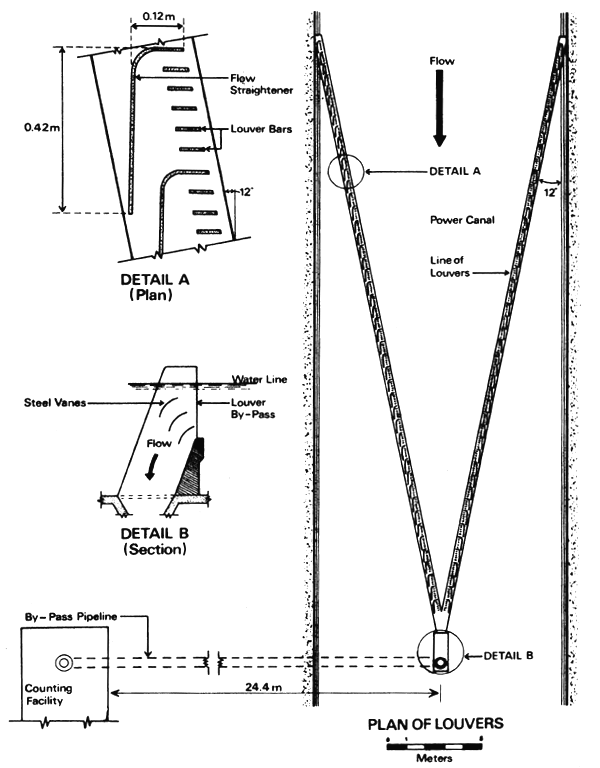
Figure 10.3 Louver deflectors used for guiding Atlantic salmon smolts from a power canal at the East River, Sheet Harbour hydroelectric site in Nova Scotia, Canada
Power generation stations other than hydroelectric stations may attract large numbers of migrating smolts in with the cooling water flow. In the River Usk in Wales, smolts entering the cooling water chambers of an estuarial power station are dip-netted out of the chambers and can be enumerated and examined for marks or tags before release.
In the western United States, the creation of artificial discharges at dams employing pump-induced flows into simulated lake or reservoir outlets have been utilized with varying degrees of success for passing downstream migrants past hydroelectric dams (Eicher, 1970).
The need to monitor changes in Atlantic salmon abundance in unobstructed rivers has resulted in a variety of fish sampling traps and weirs being utilized for the capture of migrating adults and young as they enter or leave specific rivers. Since sampling traps capture only a portion of the run, care must be taken in extrapolating sampling results to the entire population. Fish weirs, on the other hand, are usually constructed so as to screen the entire flow of the river enabling biologists to obtain exact counts of adult salmon moving upstream to spawn. Most weirs are designed so as to enable the downstream migrants to be counted as well.
Sampling traps are described in Chapter 5. Advantages of this technique can be illustrated by the data collected in the Miramichi River estuary, New Brunswick, Canada. The sampling trap located there has enabled recent declines in Atlantic salmon originating from that river to be identified (Ruggles and Turner, 1973).
Figure 10.4 depicts the yearly catch of both large salmon and grilse, together with the estimated potential egg deposition represented by these fish. Potential egg deposition was calculated by determining the sex ratios in the catch and the average fecundity of various sized females. The decline in large salmon over the period 1961–72 has had a serious effect on the potential egg deposition in the river. Potential egg deposition has shown a downward trend for over a decade with some modest improvement indicated for the last few years. This improvement is due to the complete closure of the local commercial fishery which was capable of taking up to 80 percent of the large female salmon entering the estuary.
Fyke nets are sometimes used to capture salmon smolts, but care must be exercised because of the danger of injury to the fish captured. Swain (1975) caught nearly 55,000 salmon smolts over a period of several years for tagging purposes in the lowest freshwater reaches of the Rivers Usk, Wye and Severn (England and Wales) using large eel fyke nets. The use of fyke nets in North America for sampling salmon smolts has almost been abandoned in favour of other downstream migrant sampling traps that have proven more effective, both in their capture rate and in their ability to protect fish from injury after capture.
Raymond and Collins (1975) describe a self-cleaning scoop trap developed for use in sampling downstream migrating Pacific salmon in the Columbia River Basin in the western United States. The trap (Figure 10.5) can be fished to a depth of 1.2 m, depending on water velocity and stream profile. The self-cleaning principle eliminated most of the debris problems. The solution is a travelling screen, to carry debris up and into the live-box where it is removed by a rotary-drum screen. The floating scoop trap is effective where water velocities exceed 1.2 m/sec.
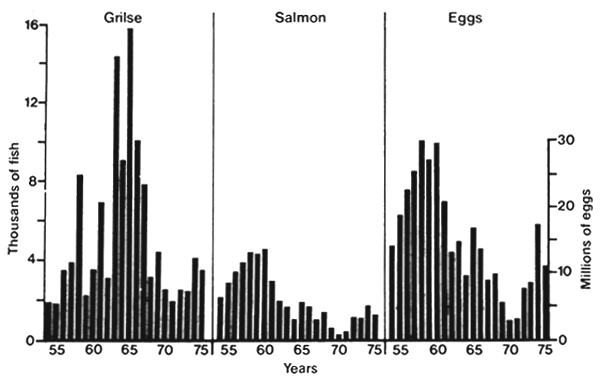
Figure 10.4 Atlantic salmon catch at Miramichi adult sampling trap from 1954 through 1975 and potential egg deposition represented by these fish
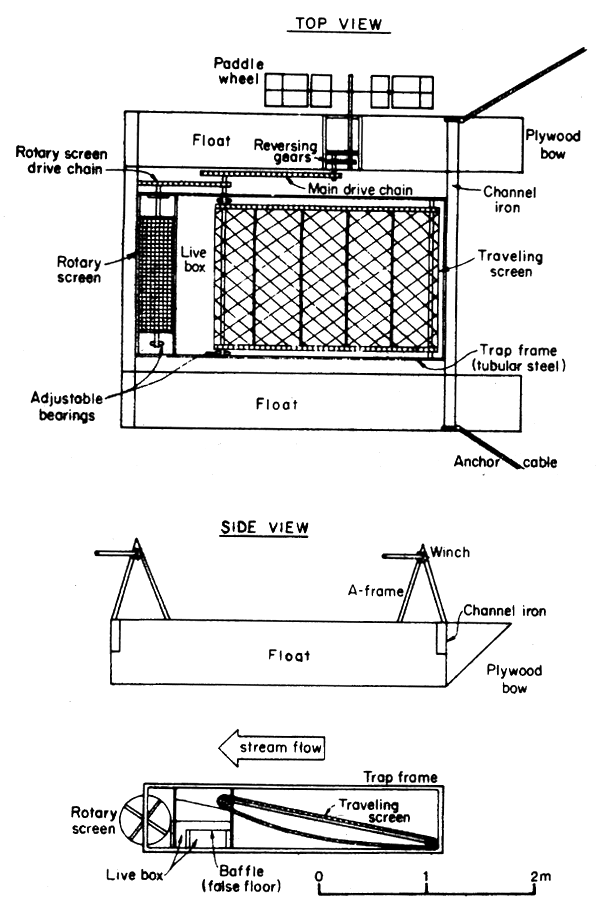
Figure 10.5 Plan and side view of floating, self-cleaning scoop trap (from Raymond and Collins, 1975)
Where water velocities are less than 1.2 m/sec, a “migrant dipper” trap (Mason, 1966) has proven effective for collecting juvenile salmon and trout from Columbia River tributaries. Kroma and Raleigh (1970) used a modified “dipper” employing louver leads to guide fish into the trap area. The basic unit consisted of a floating trap section 12.2 m long, 7.6 m wide, 1.8 m deep, with fixed louver leads that extended 9.8 m upstream at a 10° angle to the flow. A self-cleaning travelling screen formed the rear of the trap and a mental screen floor extended upstream to the two fixed louver sections.
In North America, the native Indians captured anadromous fishes by means of brush weirs or fences constructed across rivers and streams. The French explorer Nicholis Denys in 1680 described an Indian fish fence common to the rivers of northern New Brunswick (Ganong, 1908). Biologists in eastern Canada have used fish weirs to study the populations of Atlantic salmon in dozens of rivers and streams throughout the region. One of the earliest descriptions of such a structure was provided by White (1939). The weirs or fences, as they are called in North America, are installed in a river so as to form a complete barrier to fish movement.
Blair (1957) describes a counting fence made of netting that was successfully employed to count ascending adult salmon and descending salmon smolts in a number of Newfoundland rivers. A modification of this fence has been described by Murray (1968).
Detailed design criteria for a variety of adult and juvenile salmon fences are provided by Clay (1961).
A portable steel fence easily transported by helicopter has recently been developed in Newfoundland. The fence utilizes closely-spaced electrical conduit pipe placed in holes in horizontal I-beam stringers. Durability is better than with older type fences, although operational failure is higher than with permanent structures secured to a weighted base.
Successful use of fences for various estimates of salmon populations and for the assessment of their behaviour in Canadian waters was described by Saunders (1967), Saunders and Sprague (1967) and Kerswill (1971). Elson (1974) using data gathered at a fence over a 20-year period analyses effects of economic growth and industrial development on the ecology of Atlantic salmon.
McGarth (1974) describes two fish fences he designed so that the total run of both upstream and downstream-migrating salmon from the Burrishoole River system in Ireland could be enumerated.
Shearer (1975) describes a trapping system on the North Esk River in Scotland. A fish fence is used for trapping a portion of the run which migrate in the river system by way of a diversion channel.
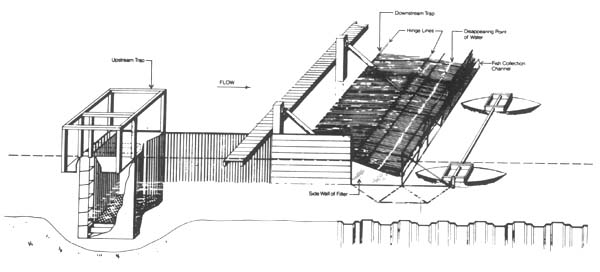
Figure 10.6
The fence on the River Axe in England (from an unpublished drawing supplied by I.R.H. Allan of the U.K. Ministry of Agriculture, Fisheries and Food)
A unique fish-counting fence was built and operated on the River Axe in southern England by the Ministry of Agriculture, Fisheries and Food (Allan, 1964 & 1965). The installation consists of two traps linked together so as to span the entire 23-metre river width (Figure 10.6). One of the traps is about 3 metres wide with a V-entrance for trapping ascending fish; the other is a large filter, stretching across the remaining 20 metres of the river for trapping descending fish.
The practical use of conventional fish weirs is restricted by the site location because of the necessity for passing the total flow through the fencing material. Several workers have experimented with electrical fish screening devices to overcome some of the problems associated with conventional fish fences.
Hartley and Weiss (1975) describe work undertaken in Scotland during recent years in developing electrical fish screens for diverting smolts. Their experience shows that migrating salmon smolts can be diverted from a line of cathodes by a sequential pattern of electrical pulses running in a constant direction along the line. Perpendicular arrays of cathodes with 60 cm spacing appear to be satisfactory. Guiding efficiency is not constant, but diversions in the order of 80 percent were obtained under experimental conditions. The construction of the electric screen is relatively simple and does not involve engineering work. Electrical power can be supplied by a portable generating set, if necessary, and the pulse-generator and distributor have proved entirely reliable over many years service.
Acoustic assessment techniques have been used in a variety of instances for assessment of Pacific salmon abundance where counts of fish are large and the relatively high capital costs of equipment can be justified by the commercial value of the species studied. These techniques are described in Chapter 9.
At the University of Maine in the eastern United States, the migratory behaviour of Atlantic salmon smolts has been studied using small radio transmitters, either attached dorsally to the fish or inserted in the stomach of the fish (U.S. Fish and Wildlife Service, 1975). Radio telemetry tracking of migrating salmon appears to be a viable method of monitoring fish movement in swift flowing rivers, since signals are unaffected by turbulence or water movement. The radio signal, however, attenuates with increasing salinity. Signals can be detected in moving boats or in moving automobiles on the highway. Aircraft surveillance is also possible. The United States Atlantic Sea Run Salmon Commission used radio tags in 1976 to monitor Atlantic salmon movements (A.L. Meister, personal communication).
Although it is not the intent of this paper to review tagging techniques developed for the study of Atlantic salmon, a recent development in this field warrants the attention of anyone concerned with the appraisal of salmon populations.
The use of the coded wire microtag (Jefferts et al., 1963) has come into widespread application in western North America in salmon fisheries, with about 30 million tags having been applied to juvenile Oncorhynchus sp. since its invention. A serious restraint in the use of the existing microtag system for application to Atlantic salmon has been the necessity for excision of the implanted tag before decoding the information on the tag.
Recent developments (Jefferts, personal communication) indicate that X-ray techniques, coupled with a new tag coding method involving cutting grooves around the periphery of the 1-mm to 2-mm long wire tags, will enable decoding of the tagging information in vivo by means of X-ray photographs. The 1-mm long tag can carry any of 64 different numbers; the 2-mm length tag 16,384.
The recovery system involves a detector which operates by sensing small changes in magnetic field caused by moving tagged specimens through an opening in the detector. The presence of a tag is indicated by an audible signal. Various types of detectors have been designed for operating in fishways or other live-fish handling facilities. Durkin, Ebel and Smith (1969) describe one device that automatically separated tagged fish from untagged fish in a fishway. An improved design of this system is described by Ebel (1973).
Most fishery biologists are acutely aware of the limitations of conventional commercial and sport catch statistics in the analysis of long and short-term changes in fish populations, hence the apparent insatiable appetite of data supplied by a large variety of ingenious sampling devices. Catch statistics, however, are often the only available indicator of stock abundance, and with experience they can be useful in determining certain changes in salmon populations. Even with other indicators available, timely catch statistics are an essential requirement for effective management of most Atlantic salmon fisheries. Often, test fishing is employed as a means of acquiring this kind of information first-hand, or when the fishery is inactive.
Local commercial fishing gear often offers an inexpensive but effective method for obtaining useful information on changes in population size and character. Many of the disadvantages, in terms of interfering with the natural migrations of relatively large runs of wild fish, can be overcome by sampling with a constant fishing effort. The catch method will then determine how representative the sample is of the entire population. Several units of gear can be utilized to obtain estimates of variance and conventional sampling theory can determine the sample size for any chosen degree of accuracy. The modified commercial salmon trap used by Ruggles and Turner (1973) is an example of an unsophisticated sampling device capable of assessing a variety of population changes in Atlantic salmon.
Whereas biologists usually abhor dams at which data can be gathered on salmon populations, they seem to have a strong affinity for fish fences. Many fishery biologists can discuss at great length the adverse effects of dams on anadromous fish populations, but too few seem to acknowledge that similar effects may result from poorly designed and operated fish fences.
All counting fences, to my knowledge, delay adult upstream spawning migrations. The extent of this delay may determine the reproductive success of a given year-class.
Extreme care must be exercised when entire runs of salmon are intercepted at either dams or fences. Population changes may be a direct effect of handling and sampling. Operating regimes should be developed to handle adequately the maximum number of fish encountered. More attention should be given to sampling theory so as to minimize the number of specimens physically handled, and therefore lessen the stress on the entire population. Care must be exercised to minimize stresses that may be selective in terms of individual races, size, sex, or other less readily recognized characteristics.
With appropriate operating safeguards, fish passes and fences are excellent tools to document changes in salmon populations.
The efficiency of fish counting installations at a particular site is dependent to a large extent on the skill and ingenuity displayed in making the site suitable. Some of the latest developments in photography and electronics offer promise for counting large numbers of mixed species at a variety of sites.
Whatever the method used to sample migrating conclusions reached by analysis of the sample must always be interpreted carefully. Good science is required to proceed from the gathering and filling of sampling data, to the establishment of biological facts useful in the protection and enhancement of a fishery.
It is a pleasure for me to acknowledge assistance received from many individuals in the preparation of this review. In particular, I should like to thank K.E.H. Smith, G.E. Turner, T.L. Marshall and D.C. Riley for providing first-hand information on sampling facilities in eastern Canada; and I.R.H. Allan, R.E. Cutting, P.F. Elson and A.L. Meister for critically reviewing the manuscript.
Allan, I.R.H., 1964 Towards logical conservation policies for our salmon and sea-trout stocks: The River Axe research. Paper presented to the River Board's Association Conference, Torquay, 7 p. (mimeo)
Allan, 1965 Counting fences for salmon trout, and what can be learned from them. Paper presented to the Salmon and Trout Association London Conference, 15 p. (mimeo)
Beach, M.H. and L.H. Walker, 1975 The application of electrical automatic counters to fisheries. EIFAC Tech.Pap., (23) Suppl.1, vol. 1:400-5
Bentley, W.W. and H.L. Raymond, 1968 Collection of juvenile salmonids from turbine intake gate-wells of major dams in the Columbia River system. Trans.Am.Fish.Soc., 97–124-6
Blair, A.A., 1957 Counting fence of netting. Trans.Am.Fish.Soc., 86:169–207
Braithwaite, H., 1975 Sonar fish counting. EIFAC Tech.Pap., (23) Suppl.1, vol.1:369-77
Clay, C.H., 1961 Design of fishways and other fish facilities. Ottawa, Queen's Printer, 301 p.
Ducharme, L.J.A., 1972 An application of louver deflectors for guiding Atlantic salmon (Salmo salar) smolts from power turbines. J.Fish.Res.Board Can., 29(10):1397-404
Durkin, J.T., W.J. Ebel and J.R. Smith, 1969 A device to detect magnetized wire tags in migrating adult coho salmon. J.Fish.Res.Board Can., 26(11):3083-8
Ebel, W.J., 1973 Use of coded wire tags for marking and automatic recovery of naturally migrating juvenile salmon and steelhead trout, La Jolla, Northwest Fisheries Center, 9 p. (mimeo)
Eicher, G. J., 1970 Fish passage. Spec.Publ.Am.Fish.Soc., 7:163-71
Elson, P.F., 1957 Number of salmon needed to maintain stocks. Can.Fish Cult., 21:19–23
Elson, 1974 Impact of recent economic growth and industrial development on the ecology of northwest Miramichi Atlantic salmon (Salmo salar). J.Fish.Res.Board Can., 31 (5) :521-44
Ganong, W.F., 1908 The description and natural history of the coast of North America (Acadia). Toronto, Publications of the Champlain Society, 437 p.
Hartley, W.G. and D.M. Weiss, 1975 The use of electrical fish screens with migrant fish populations. EIFAC Tech.Pap., (23)Suppl.1, vol.1:169-72
Jefferts, K.B., P.K. Bergman and H.F. Fiscus, 1963 A coded wire tagging system for macroorganisms. Nature, Lond., 198:460-2
Kerswill, C.J., 1971 Relative rates of utilization by commercial and sport fisheries of Atlantic salmon (Salmo salar) from the Miramichi River, New Brunswick. J.Fish.Res.Board Can., 28(3):351-63
Lawson, K.M., 1975 The electronic monitoring of salmon in Lancashire, England. EIFAC Tech.Pap., (23)Suppl.1, vol.1:388-99
Long, C.W., 1968 The movement and vertical distribution of juvenile anadromous fish in turbine intakes. Fish.Bull.U.S.Fish Wildl.Serv., 66:599–609
Mason, J.E., 1966 The migrant dipper: a trap for downstream migrating fish. Prog.Fish-Cult., 28(2):96–102
Mathisen, O.A. and E.P. Nunnallee, 1975 Acoustic stock estimation as a tool in management of sockeye salmon (Oncorhynchus nerka, Walbaum) runs. EIFAC Tech.Pap., (23) Suppl. 1, vol.1:346-63
McGrath, C.J., 1974 The fish trapping installation at the Salmon Leap, Furnace, Co. Mayo. Paper presented to the EIFAC Symposium on Methodology for the Survey, Monitoring and Appraisal of Fishery Resources in Lakes and Large Rivers, Aviemore, Scotland, May 1974. Rome, FAO, EIFAC/74/l/Symp-20:9 p.
Allan, 1975 A report on fish counting installations in Ireland. EIFAC Tech.Pap., (23) Suppl.1, vol.2:447-65
Murray, A.R., 1968 Estuarine net counting fence for trapping Atlantic salmon. Trans.Am.Fish. Soc., 97:282-6
Raymond, H.L. and G.B. Collins, 1975 Techniques for appraisal of migrating juvenile anadromous fish populations in the Columbia River Basin. EIFAC Tech.Pap., (23) Suppl. 1, vol.2:552-65
Ruggles, C.P. and G.E. Turner, 1973 Recent changes in stock composition of Atlantic salmon (Salmo salar) in the Miramichi River, New Brunswick. J.Fish.Res.Board Can., 30 (6):779-86
Saunders, R.L., 1967 Seasonal pattern of return of Atlantic salmon in the Northwest Miramichi River, New Brunswick. J.Fish.Res.Board Can., 24(1):21–32
Saunders, R.L. and J.B. Sprague, 1967 Effects of copper-zinc mining pollution on a spawning migration of Atlantic salmon. Water Res., 1:419-32
Sample, J.R., 1977 Video television and sonar sampling techniques in the study of adult alewives at a hydroelectric dam. Tech.Rep.Ser.Freshwat.Anadrom.Div.Fish.Mar.Serv., (MAR/T-77-1):7 p.
Shearer, W.M., 1975 The estimation of juvenile salmon (Salmo salar L.) populations in the North Esk, Scotland. EIFAC Tech. Pap., (23)Suppl.1, vol.2:571-80
Simpson, D. and A.M.Clark, 1975 Conception and development of electrical resistivity fish counters. EIFAC Tech.Pap., (23) Suppl.1, vol.1:414-34
Swain, A., 1975 The migrations of salmon (Salmo salar, L.) from three rivers entering the Severn estuary. ICES, CM 1975/M:10, 8 pp.
Trefethen, P.S. and G.B. Collins, 1975 Techniques for appraising adult salmon and trout populations in the Columbia River Basin. EIFAC Tech.Pap., (23) Suppl.1, vol.2:490–501
U.S. Fish and Wildlife Service, 1975 Evaluation of radio telemetry methods for monitoring Atlantic salmon smolt movement. Laconia, New Hampshire, USFWS, Special report, July 24, 10 p. (mimeo)
White, H.C., 1939 Bird control to increase the Margaree River salmon. Bull.Fish.Res.Board Can., (58):30 p.
Wood, F.E.A. and B.Mason, 1971 Echo sounder enumeration of Rivers Inlet sockeye salmon, 1967-70. Tech.Rep.Can.Dep.Fish.For.Pac.Reg., (1971-12):40 p.